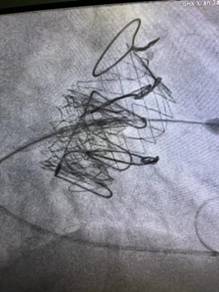Over 20 years ago, a female patient, Mrs. Zhang, underwent biological mitral valve replacement due to "mitral insufficiency complicated with prolapse" at a local hospital. Four years ago, she was hospitalized due to intermittent chest tightness and shortness of breath, and diagnosed with "biological mitral valve prolapse combined with severe insufficiency and aortic valve calcification combined with insufficiency". Subsequently, she received transapical transcatheter mitral valve-in-valve (TMViV) and transcatheter aortic valve implantation (TAVI). After a systematic treatment, she was discharged.
Over the past two months, the patient has experienced recurring chest tightness and dizziness of unknown causes. Her symptoms were aggravated gradually and her tolerance for activity was significantly worsened. She was diagnosed with "mitral valve-in-valve failure complicated with mitral regurgitation" requiring prompt surgery.
All biological valves lack of long-term durability. Over time, the replaced biological valve will undergo structural valve degeneration. Once valve failure or dysfunction occurs, surgery should be performed immediately to avoid life-threatening risks.
The patient's condition was thoroughly evaluated by Director Yan Yang and Party Secretary Zheng Jianjie from the Department of Cardiovascular Surgery. The team finally decided to perform a "mitral valve-in-valve implantation through femoral vein atrial septum". Traditionally, artificial biological valve failure or damage could only be corrected through re-surgery with cardiopulmonary bypass. However, perform second valve surgery through medianthoracotomy for high-risk elderly patients is a huge challenge, even in experienced heart surgery centers. Valve-in-valve procedures involve implanting a new valve inside a damaged valve to resolve the problem of valve failure after biological cardiac valve replacement with mild trauma. Valve-in-valve surgery can not only prevent patients from undergoing thoracotomy in the third heart surgery, but also significantly mitigate the trauma, lower surgical risk and accelerate postoperative recovery of patients.
On December 1, with intimate cooperation with the Department of Anesthesiology and Perioperative Medicine, Interventional Operation Room, Department of Ultrasound Medicine and other departments, the cardiovascular surgery team successfully implanted a SAPIEN 3 aortic valve into the mitral valve position through femoral vein and atrial septum puncture following preoperative plans, and successfully completed "mitral valve-in-valve implantation through femoral vein and atrial septum puncture". Postoperative angiocardiography displayed that the valve-in-valve was implanted in the proper position, the mitral valve could open and close normally, and no mitral regurgitation was found. The patient was transferred to the ICU of Department of Cardiovascular Surgery for monitoring and treatment. Next day, she was transferred to general ward. Echocardiography showed that the patient's cardiac function was significantly improved. It is the first surgery of this kind in northwest China, and it is also the first case of femoral vein valve implantation after J-V mitral valve-in-valve failure and J-V double valve replacement.

